Decline in Nature: an Intertextual Study
Abstract
Human and nature had been living side by side and help each other since ancient times. However, the current condition of nature had pushed other humans to be aware that this ‘side by side living’ had not only been advantageous but also exploited. This is recorded by humans through literacy; starting from poems. However, these records did not only contain history but also expressions of poets and authors alike; their perspective of nature they see in their existence and or, perhaps, their hope or view of the future of nature. To find whether a work conveys life through nature or whether it conveys nature from different aspects of life, a study is needed. This writing aims to interpret the nature represented in William Blake’s The Tyger and Gordon J. L. Ramel’s Tiger, Tiger Revisited. The method used is library research and the approach used in intertextuality by focusing on the human-wildlife relationship over the years both poems were written. The results show that these poems are similar in their nature as poems. However, their idea of nature contradicts each other in the use of the figure of speech. Nature had changed drastically over the years these poems are made, and those changes are conveyed within the two poems.






